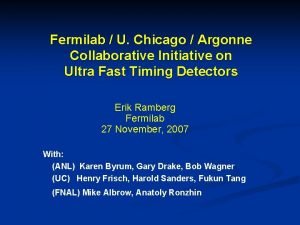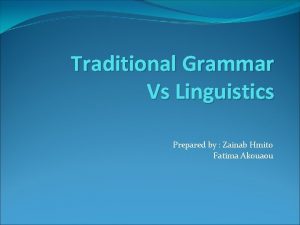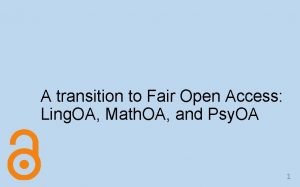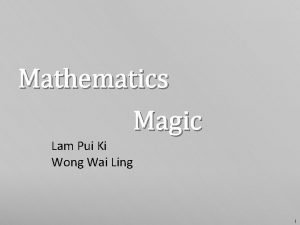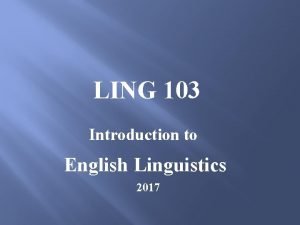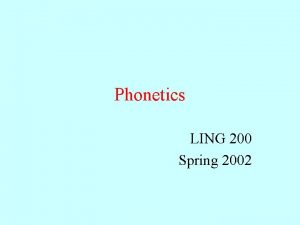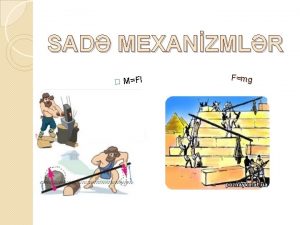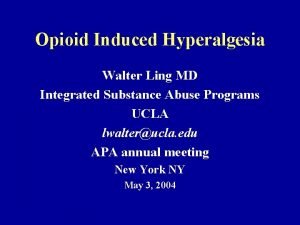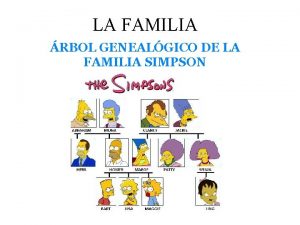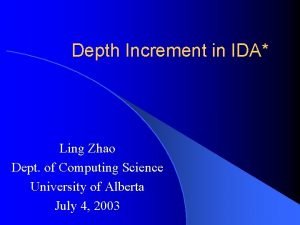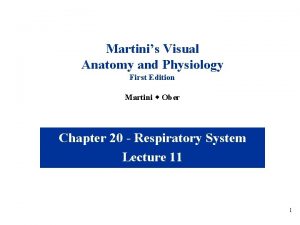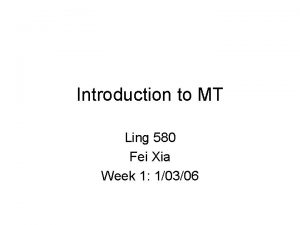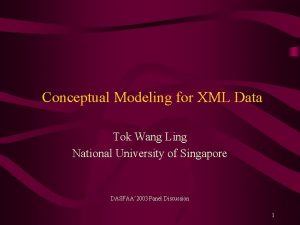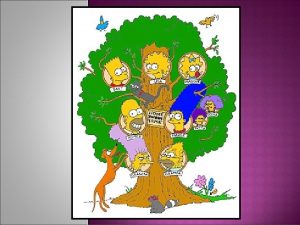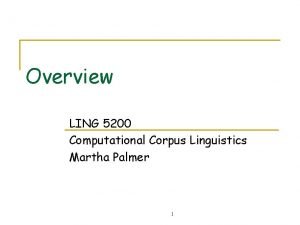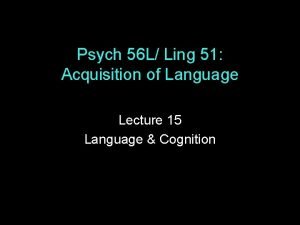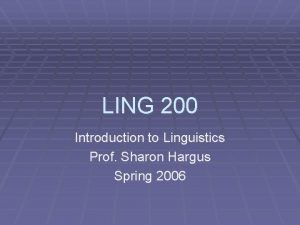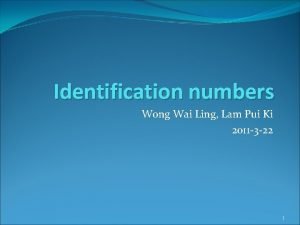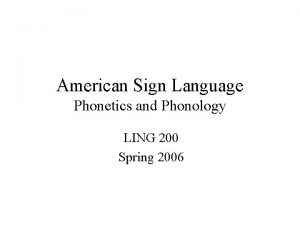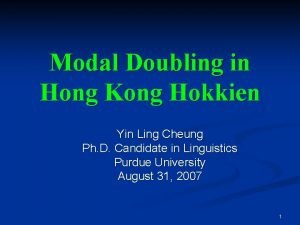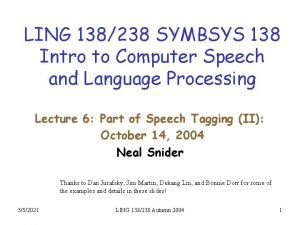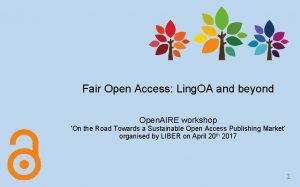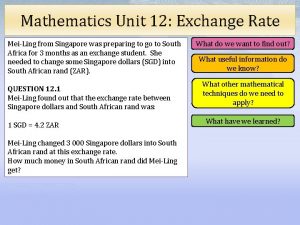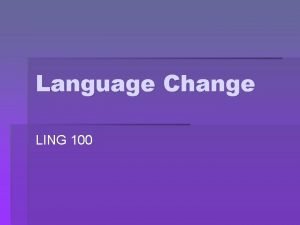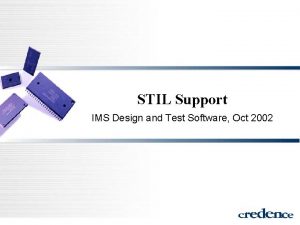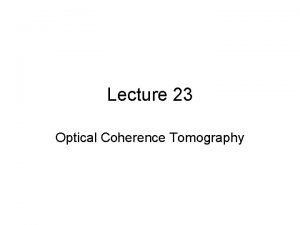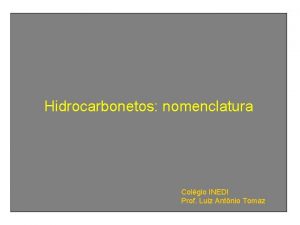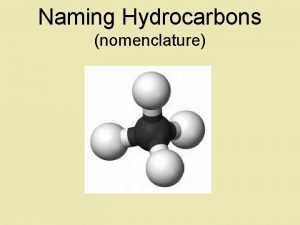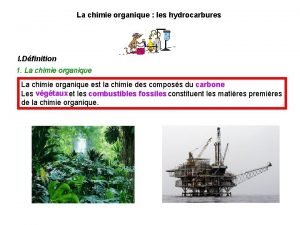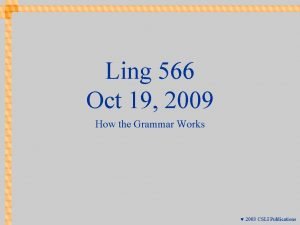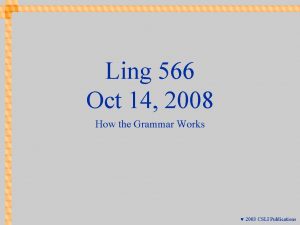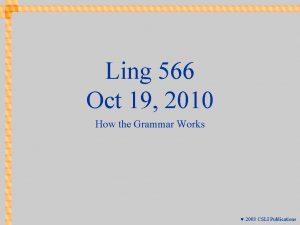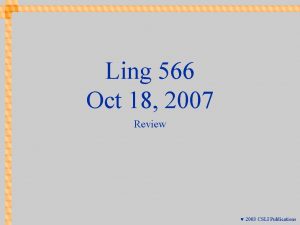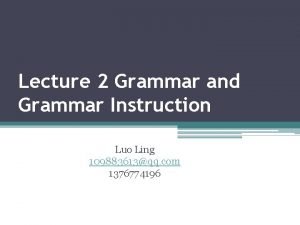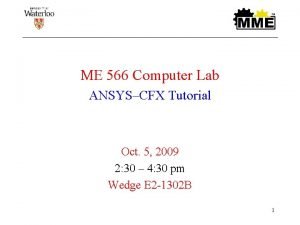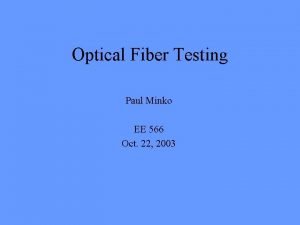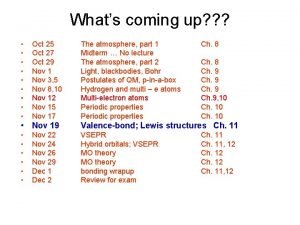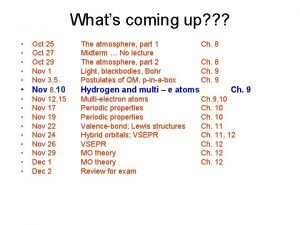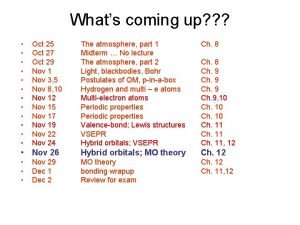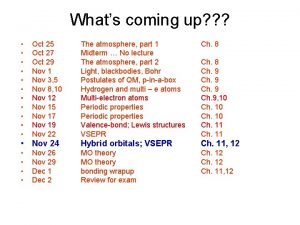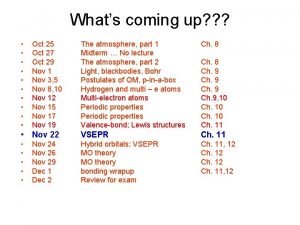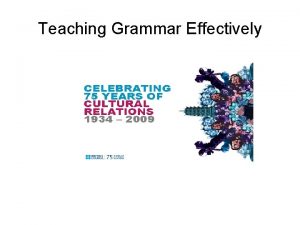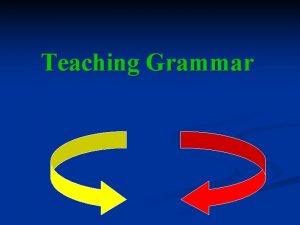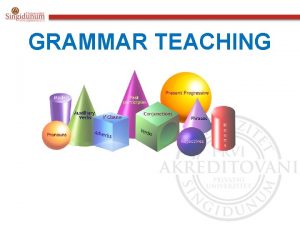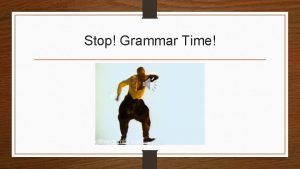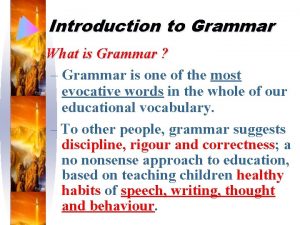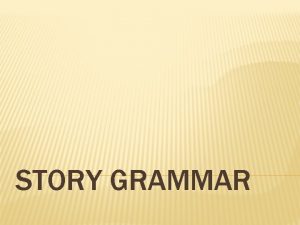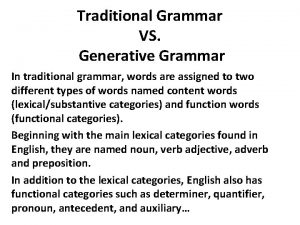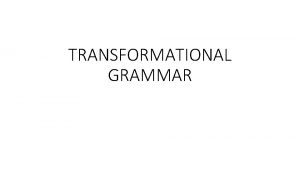Ling 566 Oct 15 2019 How the Grammar


























































- Slides: 58

Ling 566 Oct 15, 2019 How the Grammar Works Ó 2003 CSLI Publications

Overview • What we’re trying to do • The pieces of our grammar • Two extended examples • Reflection on what we’ve done, what we still have to do • Reading questions 2 Ó 2003 CSLI Publications

What We’re Trying To Do • Objectives • • • Develop a theory of knowledge of language Represent linguistic information explicitly enough to distinguish well-formed from ill-formed expressions Be parsimonious, capturing linguistically significant generalizations. • Why Formalize? • • • To formulate testable predictions To check for consistency To make it possible to get a computer to do it for us 3 Ó 2003 CSLI Publications

How We Construct Sentences • The Components of Our Grammar • • • Grammar rules Lexical entries Principles Type hierarchy (very preliminary, so far) Initial symbol (S, for now) • We combine constraints from these components. • Q: What says we have to combine them? 4 Ó 2003 CSLI Publications

An Example A cat slept. • Can we build this with our tools? • Given the constraints our grammar puts on well-formed sentences, is this one? 5 Ó 2003 CSLI Publications

Lexical Entry for a • • • 6 Is this a fully specified description? What features are unspecified? How many word structures can this entry license? Ó 2003 CSLI Publications

Lexical Entry for cat • • 7 Which feature paths are abbreviated? Is this a fully specified description? What features are unspecified? How many word structures can this entry license? Ó 2003 CSLI Publications

Effect of Principles: the SHAC 8 Ó 2003 CSLI Publications

Description of Word Structures for cat Ó 2003 CSLI Publications

Description of Word Structures for a 10 Ó 2003 CSLI Publications

Building a Phrase 11 Ó 2003 CSLI Publications

Constraints Contributed by Daughter Subtrees 12 Ó 2003 CSLI Publications

Constraints Contributed by the Grammar Rule 13 Ó 2003 CSLI Publications

A Constraint Involving the SHAC 14 Ó 2003 CSLI Publications

Effects of the Valence Principle 15 Ó 2003 CSLI Publications

Effects of the Head Feature Principle 16 Ó 2003 CSLI Publications

Effects of the Semantic Inheritance Principle 17 Ó 2003 CSLI Publications

Effects of the Semantic Compositionality Principle 18 Ó 2003 CSLI Publications

Is the Mother Node Now Completely Specified? 19 Ó 2003 CSLI Publications

Lexical Entry for slept 20 Ó 2003 CSLI Publications

Another Head-Specifier Phrase Key HSR SHAC Val Prin HFP SIP SCP 21 Ó 2003 CSLI Publications

Is this description fully specified? Ó 2003 CSLI Publications

Does the top node satisfy the initial symbol? Ó 2003 CSLI Publications

RESTR of the S node 24 Ó 2003 CSLI Publications

Another Example 25 Ó 2003 CSLI Publications

Head Features from Lexical Entries 26 Ó 2003 CSLI Publications

Head Features from Lexical Entries, plus HFP 27 Ó 2003 CSLI Publications

Valence Features: Lexicon, Rules, and the Valence Principle Key Lexicon Val. Prin. Ó 2003 CSLI Publications

Required Identities: Grammar Rules Ó 2003 CSLI Publications

Two Semantic Features: the Lexicon & SIP Ó 2003 CSLI Publications

RESTR Values and the SCP 31 Ó 2003 CSLI Publications

An Ungrammatical Example What’s wrong with this sentence? 32 Ó 2003 CSLI Publications

An Ungrammatical Example What’s wrong with this sentence? So what? 33 Ó 2003 CSLI Publications

An Ungrammatical Example The Valence Principle 34 Ó 2003 CSLI Publications

An Ungrammatical Example Head Specifier Rule ¬c ont rad icti on ® 35 Ó 2003 CSLI Publications

Exercise in Critical Thinking • Our grammar has come a long way since Ch 2, as we've added ways of representing different kinds of information: • generalizations across categories • semantics • particular linguistic phenomena: valence, agreement, modification • What else might we add? What facts about language are as yet unrepresented in our model? 36 Ó 2003 CSLI Publications

Overview • What we’re trying to do • The pieces of our grammar • Two extended examples • Reflection on what we’ve done, what we still have to do • Reading questions 37 Ó 2003 CSLI Publications

Reading Questions • I have a question about the "+ in circle" symbol. When should we use that symbol and when should we use the list symbol <>? Is this two symbol the same? • [A] (+) [B] • < [1] > (+) < [2] > • BAD BAD: < [A] (+) [B] > 38 Ó 2003 CSLI Publications

Reading Questions • For the example "They sent us a letter" - It's clear to me why having the role for ‘addressee’ does not cause any problems, but I am still confused as to what the argument for including it in the entry is. Why include it if it doesn't tie to anything else? Is it essential to list it? • How do we know how many arguments to posit in a lexical entry? 39 Ó 2003 CSLI Publications

Reading Questions • The comparison of the two interpretations for "They sent a letter to Lee" made me wonder if it's always possible to distinguish between syntactic ambiguities by means of the semantic feature structures, or are there other cases where that is not enough? • What's up with that entry for us? 40 Ó 2003 CSLI Publications

Reading Questions • In-spite of this formalism of how syntax and semantic flows through a tree/phrase, because the RESTR values are driven by the word/lexicon itself and different words can have different values to specify these relations, doesn't this restrict the ability of the grammar to generalize? Aren't we going to end up with a grammar that is too specific to the sentence it is parsing, given that we are letting the word dictate the semantic and syntactic relations. 41 Ó 2003 CSLI Publications

Reading Questions • • "When the Head-Specifier Rule enforces this identity, it forms a link in a chain of identities: . . . This chain of identities ensures that the BV of the exist predication and the INST of the letter predication are one and the same (k). " page 172173 Is this identity chain referring to the RESTR list? When the final RESTR list turns into something like "[RELN two, BV k] + [RELN letter, INST k, ADDRESSEE m] +. . . ", is the chain an idea that binds (k) to two and letter? 42 Ó 2003 CSLI Publications

Reading Questions • In the lexical entry for 'send', why can both complements have accusative case? Why don't we need something like dative case for the second complement to avoid accepting *they gave a letter us? • Why do we bother including a CASE feature in English examples where it isn't marked? Is it to help select for the position in a sentence? For example, showing what kindsof NPs could be a complement to a prepositional phrase? 43 Ó 2003 CSLI Publications

Reading Questions • "There are infinitely many word structures that satisfy (5)". I see why it can satisfy several structures once it starts combining with COMPS, SPRS, and the list of RESTR values becomes modified, but isn't the idea of having both syntactic and semantic information in the lexical entry in precise specification of allowable contexts for this entry, therefore there should be a limit to the features it can take? 44 Ó 2003 CSLI Publications

Reading Questions • I found it really interesting that lexical entries imply an infinite amount of licensed structures. Our grammar rules allow for infinite possible structures, and now this chapter made it evident that lexical entries allow this two. It seems that this is because lexical entries involve features that specify something related to the grammar rules. That being so, I wonder if we can say that the productivity of language is due to both lexical entries and grammar rules for truly distinct reasons, or if they both boil down being the same exact source of the productivity. 45 Ó 2003 CSLI Publications

Reading Questions • I am confused about this statement, "Each rule says, in effect, that subtrees of a certain kind are sanctioned, but the rule only specifies some of the constraints that the trees that it licenses must obey, " (Page 168) especially the first half. More illustration of this statement will be greatly appreciated. 46 Ó 2003 CSLI Publications

Reading Questions • Is there an equivalence between underspecification and optional components? For example in the lexical entry for letter (5), the complement indicates the word can take an optional PP. If COMPS were to be excluded from the entry would that also mean that letter can take an optional PP (or any other phrase for that matter)? 47 Ó 2003 CSLI Publications

Reading Questions • I wonder if the grammar coule solve the problem of word order in languages? The RESTR list seems not to have the restrictions on the order of the complements(i. e send). 48 Ó 2003 CSLI Publications

Reading Questions • I’d like further clarification on the reasonings behind not supporting TENSE in our feature structures. It feels like such a significant feature that leaving it out is confusing. Especially since this current chapter even shows a certain different between 'send' and 'sent'. They're marked differently, but not in ways one would normally suspect. 49 Ó 2003 CSLI Publications

Reading Questions • I had some trouble understanding why the COMPS list was different between in the lexical entries for "sent" and "send" on pages 175 and 183. I understand that these values are appropriate for the respective trees these verbs are placed in, but my understanding was that lexical entries are underspecified and then filled in when placed as part of the tree. If the actual lexical entries are different in the abstract (unrelated to the trees they're placed in), I'm hoping to get some clarification on why. It tentatively seems like they could be used much the same way. 50 Ó 2003 CSLI Publications

Reading Questions • "By far the richest source of information in this factorization is the lexicon. " Does this statement hold for languages (unlike English) that have rich inflectional, derivational, and case structures? Or are these other systems inherently present in our model of the lexicon? 51 Ó 2003 CSLI Publications

Reading Questions • Is BV exclusive to determiners or does it apply to all specifiers? The purpose of BV is just to show the word's connection to the head, correct? • What is the difference between INST and INDEX? 52 Ó 2003 CSLI Publications

Reading Questions • How does our system enforce semantic acceptability for sentences that are syntactically grammatical? For example, a sentence like 'I drank the pizza' is syntactically sound, but it sets off some semantic alarms. Is this determined in the lexicon? In other words, do we need to have a feature for everything that determines if something is drinkable or not? If this is the case, it seems like we could keep on breaking down words into finer and finer detail endlessly. 53 Ó 2003 CSLI Publications

Reading Questions • Would we create entirely new grammars based on the usage contexts and situations? Two situations I can think of are newspaper headlines, which often eliminate determiners, and works of fiction, where we can relax semantic constraints for certain words. If so, would such grammars have a lexicon that only includes words applicable to the situation at hand? 54 Ó 2003 CSLI Publications

Reading Questions • All the examples of lexical entries that we've been given, if I’m not mistaken, are for words. Is it possible to have lexical entries for phrases or expressions? I imagine those would look like mother phrases in trees as in (10). If not, why bother specifying 'word' in each lexical entry? 55 Ó 2003 CSLI Publications

Reading Questions • 'we moved more and more syntactic information out of grammar rules and into the lexicon'. But since we have a large lexicon with many groups of similar entries now, can we just categorise the lexicon entries with, say, a type hierarchy that includes type *verb-pl*, *noun-proper* and so on? 56 Ó 2003 CSLI Publications

Reading Questions • In practice, are there situations where it would make sense to draw these trees from the top-down, rather than bottom-up? 57 Ó 2003 CSLI Publications

Reading Questions • Do we have to understand the squiggly bits in 6. 3? • => 6. 3. 5 and 6. 3. 6 only. 58 Ó 2003 CSLI Publications
 Jhlt. 2019 oct; 38(10): 1015-1066
Jhlt. 2019 oct; 38(10): 1015-1066 Jhlt. 2019 oct; 38(10): 1015-1066
Jhlt. 2019 oct; 38(10): 1015-1066 Jhlt. 2019 oct; 38(10): 1015-1066
Jhlt. 2019 oct; 38(10): 1015-1066 Jhlt. 2019 oct; 38(10): 1015-1066
Jhlt. 2019 oct; 38(10): 1015-1066 Ortec 566 tac
Ortec 566 tac Decreto legislativo 566/20
Decreto legislativo 566/20 Traditional school of linguistics
Traditional school of linguistics Chomsky hierarchy
Chomsky hierarchy Right linear grammar to left linear grammar
Right linear grammar to left linear grammar Left linear grammar to right linear grammar
Left linear grammar to right linear grammar Ling oa
Ling oa Magic lam
Magic lam Ling
Ling Ling shih fu
Ling shih fu Ling 200
Ling 200 Sadə mexanizmlər ling
Sadə mexanizmlər ling The pulmonary semilunar valve
The pulmonary semilunar valve Walter ling
Walter ling Como se llaman las hermanas de marge simpson
Como se llaman las hermanas de marge simpson Ida ling
Ida ling Martini anatomy
Martini anatomy Mt ling
Mt ling Wang ling relationship
Wang ling relationship Ling simpson
Ling simpson Ling internet
Ling internet Ling
Ling False belief test
False belief test Ling
Ling Dr ng li ling
Dr ng li ling Short term goal examples
Short term goal examples Lam wai ling
Lam wai ling Shi sheng ling
Shi sheng ling Ling adder
Ling adder Agnes ling
Agnes ling Minimal pair asl
Minimal pair asl Erin ling
Erin ling Cheung yin ling
Cheung yin ling Ling
Ling Nien-ling wacker
Nien-ling wacker Mei-ling huang
Mei-ling huang Ling rolled
Ling rolled Ling oa
Ling oa Jin ling cigarettes
Jin ling cigarettes Johann bernhard basedow contribution in physical education
Johann bernhard basedow contribution in physical education Mei-ling from singapore was preparing
Mei-ling from singapore was preparing Ling 100
Ling 100 Hydrocarbons contain only _____.
Hydrocarbons contain only _____. Erg vizsgálat
Erg vizsgálat Stil oct
Stil oct Low na
Low na Hidrocarbonetos ramificados
Hidrocarbonetos ramificados Chemistry organic
Chemistry organic Visante oct
Visante oct About gandhi in english
About gandhi in english Meth eth prop but mnemonic
Meth eth prop but mnemonic Meth eth prop
Meth eth prop Crash course chemistry naming compounds
Crash course chemistry naming compounds Propylhexane formule semi-développée
Propylhexane formule semi-développée Scleral lens oct
Scleral lens oct




